Characteristics
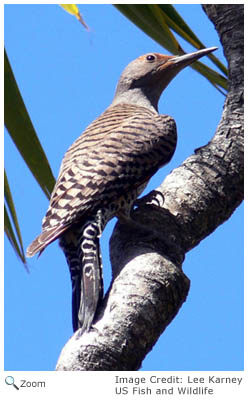 The northern flicker is a large brown woodpecker. It has a white tail with black bars and a black tip, a light brown to off-white breast with black to brown spots. it has a black "bib" on its upper chest. Males have a black or red "mustache" that runs from its bill down to its cheek. The northern flicker is a large brown woodpecker. It has a white tail with black bars and a black tip, a light brown to off-white breast with black to brown spots. it has a black "bib" on its upper chest. Males have a black or red "mustache" that runs from its bill down to its cheek.
There are five subspecies of northern flicker:
the yellow-shafted flicker, the red-shafted flicker, the gilded flicker, the Guatemalan flicker, and the Cuban flicker
and throat color, head color and the presence of a red marking on the neck can vary depending on the subspecies.
 The yellow-shafted flicker has a red patch on its neck and yellow feathers on the inside of its wings. The male has a black mustache. Yellow-shafted flickers can be found in the east and the north. The red-shafted flicker has pinkish feathers on the inside of its wings and the male has a red mustache. The red-shafted flicker is common in the west. The gilded flicker can be found in the deserts of southeastern California and southern Arizona. It has yellow wing linings and the males have a red mustache. The yellow-shafted flicker has a red patch on its neck and yellow feathers on the inside of its wings. The male has a black mustache. Yellow-shafted flickers can be found in the east and the north. The red-shafted flicker has pinkish feathers on the inside of its wings and the male has a red mustache. The red-shafted flicker is common in the west. The gilded flicker can be found in the deserts of southeastern California and southern Arizona. It has yellow wing linings and the males have a red mustache.
Range
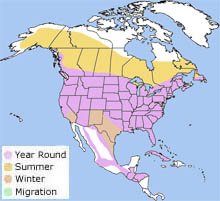 The flicker can be found in much of North America from the tree line in Canada and Alaska south to Nicaragua. Flickers in Alaska and Canada are migratory. The flicker can be found in much of North America from the tree line in Canada and Alaska south to Nicaragua. Flickers in Alaska and Canada are migratory.
|
|
Habitat
The northern flicker can be found in open forests, woodlots and groves. It is common in parks and gardens.
Diet
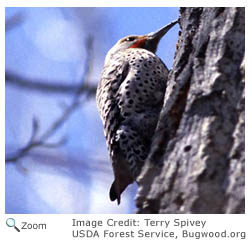 The flicker's diet is mostly insects, including ants. They also eat termites, beetles, caterpillars, fruits, and berries. They will sometimes eat seeds and nuts. The flicker's diet is mostly insects, including ants. They also eat termites, beetles, caterpillars, fruits, and berries. They will sometimes eat seeds and nuts.
Life Cycle
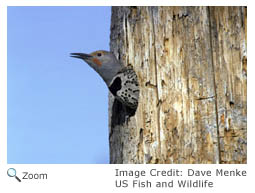 During courtship, flickers peck or "hammer" on dead tree limbs or tin roofs. In some parts of the United States, flickers are known as yellowhammers! During courtship, flickers peck or "hammer" on dead tree limbs or tin roofs. In some parts of the United States, flickers are known as yellowhammers!
They build their nests in holes in trees, telephone poles or birdhouses. Gilded flickers may build their nests in cactuses. The female will usually lay six to eight eggs. Both the male and female incubate the eggs for 11-16 days. Both parents feed the fledglings regurgitated food.
The chicks will leave the nest about four weeks after hatching. At first, the parents will continue to feed them, but they will eventually learn to forage for food on their own. Flickers in the north have one brood a year; in the south they may have two broods.
Behavior
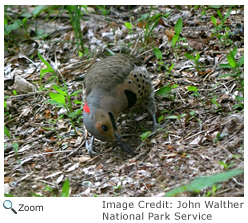 The flicker is the only woodpecker in North American that commonly finds food on the ground. It often forages for ants and beetle larvae on the ground. It will sometimes perch on tree limbs to eat berries. The flicker is the only woodpecker in North American that commonly finds food on the ground. It often forages for ants and beetle larvae on the ground. It will sometimes perch on tree limbs to eat berries.
|